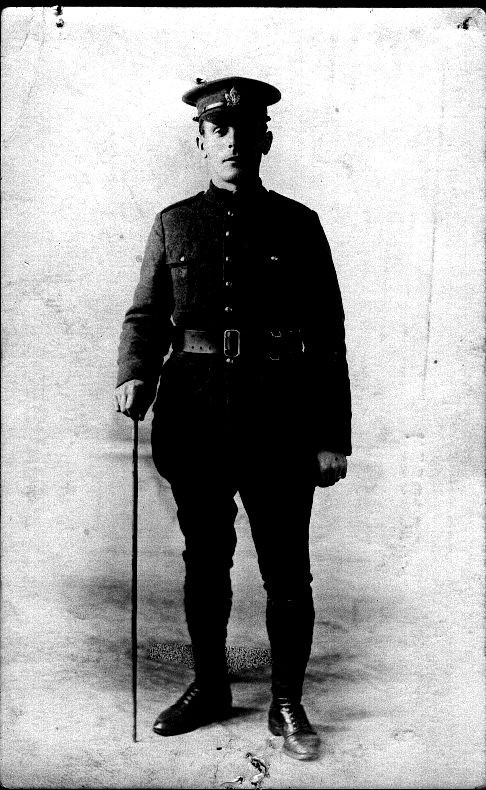Pte
Edwin Grant
Informatie over geboorte
|
Geboortedatum: 10/12/1884 |
|
Geboorteplaats: Aberdeen, Aberdeenshire, Schotland, Verenigd Koninkrijk |
Algemene Informatie
|
Beroep: Staalarbeider |
Informatie legerdienst
|
Land: Canada |
|
Strijdmacht: Canadian Expeditionary Force |
|
Rang: Private |
|
Service nummer: 703562 |
|
Dienstneming datum: 09/02/1916 |
|
Dienstneming plaats: Vancouver, British Columbia, Canada |
|
Eenheden: — Canadian Infantry, 47th Bn. (British Columbia) (Laatst gekende eenheid) |
Informatie over overlijden
|
Datum van overlijden: 26/10/1917 |
|
Plaats van overlijden: Hill 37, België |
|
Doodsoorzaak: Killed in action (K.I.A.) |
|
Leeftijd: 32 |
Begraafplaats
|
Tyne Cot Cemetery Plot: XVI Rij: G Graf: 7 |
Onderscheidingen en medailles 2
|
British War Medal Medaille |
|
Victory Medal Medaille |
Points of interest 2
| #1 | Geboorteplaats | ||
| #2 | Dienstneming plaats |
Mijn verhaal
Edwin Grant was born in Aberdeen, Schotland in 1884. At the age of 22, Edwin emigrated to Canada, where he started working as a Steel worker. In February 1916 he joined the Canadian Expeditionary Force. His medical examination details mentions distinctive tattoos, which included a butterfly and bird on his left arm and a butterfly and Geisha girl on his right. By the time of the Battle of Passchendaele, Edwin served with “B” Company, of the 47th Battalion Canadian Infantry (British Columbia), part of the 10th Brigade, of the 4th Canadian Division.
In the early hours of the 25th of October 1917, the 47th Battalion moved up in support at Abraham Heights. On the 26th, Edwin’s Battalion was still in close support at Abraham Heights, when the 4th Division attacked astride the Passchenaele Road, with the 46th Battalion (Saskatchewan). The jump-off line was situated at Hillside Farm, between Heine House and the Ypres-Roulers Railroad. The 46th Battalion was able to consolidate most of their objectives, including Decline Copse.
In the meanwhile, the 47th Battalion had received orders to relieve parts of the 50th Battalion (Alberta Regiment) in front of the original frontline. During the afternoon three German counterattacks forced the Saskatchewanians and Alberta Regiment back. Many disorganized parties of the 46th and 50th Battalion came running back, but the line of the 47th held. When the line was reorganized “B” Company moved forward to the northeast side of the Passchendaele Road and consolidated a line between the road and the Railway Embankment near Decline Copse. The Australians, of the 1st Australian Division, were on the right of the Railroad.
On the following day, the 47th remained in the new frontline, while the German artillery heavily shelled their positions. At night, the whole Battalion, in conjunction with the 44th Battalion, was ordered to advance and occupy a ridgeline, which was lost on the previous day. By 10 a.m., the Battalions had successfully regained all positions. At this time “B” Company was back in support between Defy Crossing and Augustus Wood.
The 28th of October was also marked by intense shelling. German aeroplanes flew over, directing the German’s artillery.
Private Edwin Grant, 33, was killed in action between 26 and 28 October 1917. He was originally buried in the field at D.20.central, near Hill 37, where the Battalion stayed before marching towards Abraham Heights. Edwin might have been killed, while moving up or was evacuated during the fighting astride the Passchendaele Road. He was later reinterred in Tyne Cot Cemetery and lies in Plot XVI Row G Grave 7. Edwin left behind his wife, Bella, who after the war had moved from Vancouver to live with Edwin’s parents in Duluth, Minnesota.
In the early hours of the 25th of October 1917, the 47th Battalion moved up in support at Abraham Heights. On the 26th, Edwin’s Battalion was still in close support at Abraham Heights, when the 4th Division attacked astride the Passchenaele Road, with the 46th Battalion (Saskatchewan). The jump-off line was situated at Hillside Farm, between Heine House and the Ypres-Roulers Railroad. The 46th Battalion was able to consolidate most of their objectives, including Decline Copse.
In the meanwhile, the 47th Battalion had received orders to relieve parts of the 50th Battalion (Alberta Regiment) in front of the original frontline. During the afternoon three German counterattacks forced the Saskatchewanians and Alberta Regiment back. Many disorganized parties of the 46th and 50th Battalion came running back, but the line of the 47th held. When the line was reorganized “B” Company moved forward to the northeast side of the Passchendaele Road and consolidated a line between the road and the Railway Embankment near Decline Copse. The Australians, of the 1st Australian Division, were on the right of the Railroad.
On the following day, the 47th remained in the new frontline, while the German artillery heavily shelled their positions. At night, the whole Battalion, in conjunction with the 44th Battalion, was ordered to advance and occupy a ridgeline, which was lost on the previous day. By 10 a.m., the Battalions had successfully regained all positions. At this time “B” Company was back in support between Defy Crossing and Augustus Wood.
The 28th of October was also marked by intense shelling. German aeroplanes flew over, directing the German’s artillery.
Private Edwin Grant, 33, was killed in action between 26 and 28 October 1917. He was originally buried in the field at D.20.central, near Hill 37, where the Battalion stayed before marching towards Abraham Heights. Edwin might have been killed, while moving up or was evacuated during the fighting astride the Passchendaele Road. He was later reinterred in Tyne Cot Cemetery and lies in Plot XVI Row G Grave 7. Edwin left behind his wife, Bella, who after the war had moved from Vancouver to live with Edwin’s parents in Duluth, Minnesota.
